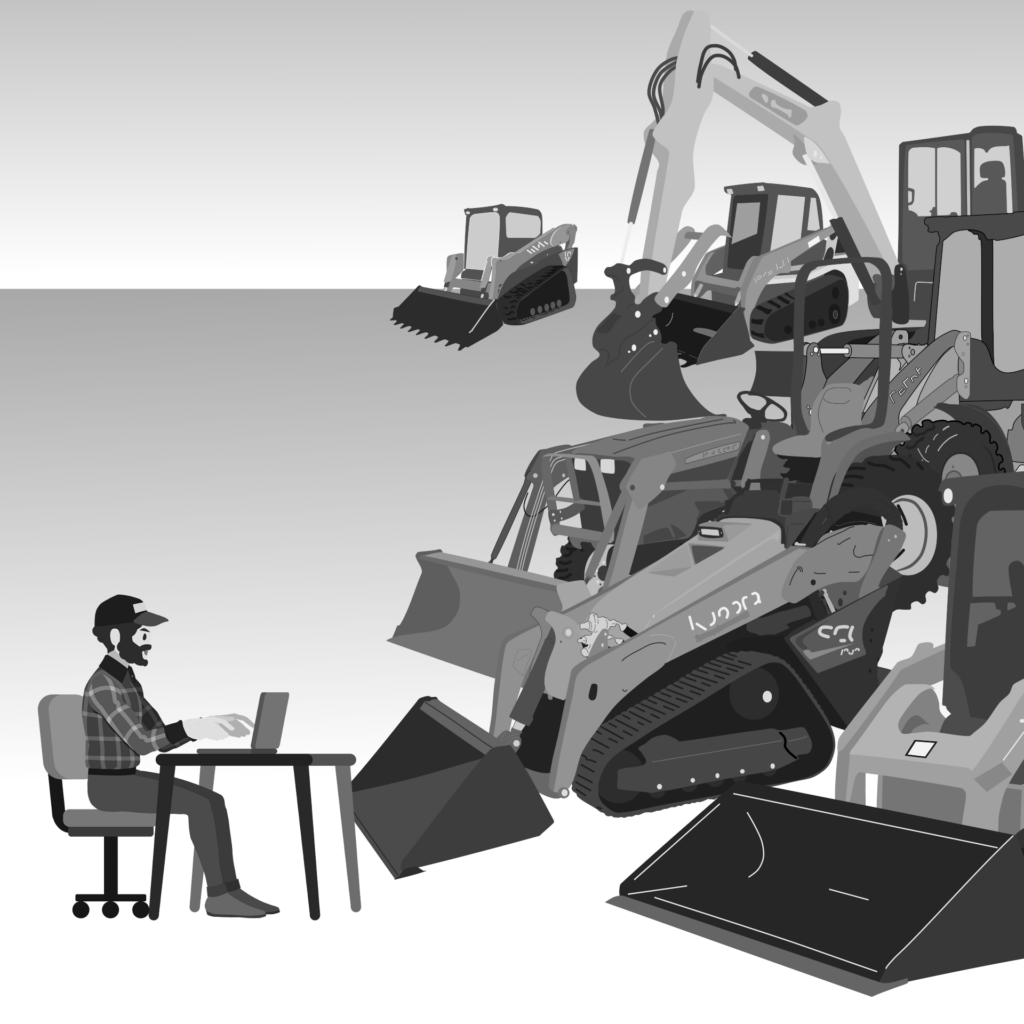
1. On-Site Physical Inspection
When you’re physically inspecting the equipment, focus on these key areas:
General Condition
- Visual Damage: Look for cracks, dents, and rust, especially on the frame and critical structural components.
- Paint Condition: Uneven or new paint may hide previous damage.
- Hours Meter: Check if it aligns with the machine’s age and condition. A suspiciously low reading might indicate tampering.
Engine and Powertrain
- Engine Oil: Check for cleanliness and consistency. Milky oil could indicate water contamination.
- Coolant and Hydraulic Fluids: Ensure proper levels, clarity, and absence of contamination.
- Exhaust Smoke: Black, blue, or white smoke during startup could signal engine issues.
- Engine Noise: Listen for unusual knocking or grinding sounds.
- Leaks: Inspect for oil, coolant, or fuel leaks around the engine and hydraulics.
Hydraulics
- Cylinders and Hoses: Look for leaks, cracks, or wear.
- Hydraulic Pump and Motors: Test the functionality by operating the boom, bucket, or other attachments.
- Pressure Levels: Verify that hydraulics maintain consistent pressure during operation.
Undercarriage and Tires (For Tracked/Loader Equipment)
- Tracks: Inspect for wear, loose bolts, or damaged track pads.
- Sprockets and Rollers: Check for excessive wear and alignment.
- Tires (Wheeled Equipment): Look for cracks, uneven wear, and tread depth.
Boom, Bucket, and Attachments
- Pins and Bushings: Inspect for excessive play or wear.
- Welding or Repairs: Check for structural repairs or cracks that might affect performance.
- Bucket Condition: Check for dents, cracks, or worn cutting edges.
Electrical and Controls
- Lights and Indicators: Ensure all lights, warning systems, and indicators function.
- Controls: Operate all controls to ensure responsiveness and accuracy.
- Battery: Check for corrosion, proper voltage, and start reliability.
Operational Test
- Startup: Ensure the machine starts smoothly without excessive cranking.
- Performance: Test movement, steering, braking, and lifting/lowering functions.
- Noise Levels: Listen for abnormal noises while the machine operates.
2. Pricing, Specifications, and Documentation
This part focuses on pre-purchase due diligence and ensuring transparency in the deal.
Pricing
- Market Research: Compare the price with similar models, considering year, usage hours, and condition.
- Cost of Repairs: Estimate costs for fixing any issues discovered during inspection.
- Resale Value: Evaluate the machine’s long-term value based on brand and model popularity.
Specifications
- Match to Needs: Confirm that the machine’s size, capacity, and power match your intended use.
- Attachments Compatibility: Check if required attachments are included and fit your needs.
- Model Upgrades: Ensure the machine is not an older version of a significantly upgraded model.
Documentation
- Ownership Records: Verify that the seller has the legal right to sell the equipment.
- Service Records: Request maintenance and repair logs to understand the machine’s history.
- Hours Validation: Cross-check hour meter readings with service logs.
- Original Invoice: Ensure the price aligns with what was initially paid if buying directly from the first owner.
Compliance
- Emissions Standards: Ensure the machine meets regulatory standards (e.g., EPA Tier 4).
- Serial Number Verification: Cross-check serial numbers on the machine and documentation to detect tampering or theft.
Warranty and Post-Sale Support
- Remaining Warranty: Check if any manufacturer or extended warranty remains.
- Support Availability: Confirm access to replacement parts and servicing in your region.
Transport and Delivery
- Shipping Costs: Include the costs of transportation to your location.
- Operational Readiness: Ensure the machine is delivered in ready-to-use condition.
Machine-Specific Considerations
- Backhoe Loader (TLB): Inspect the articulation points and hydraulic system for the backhoe and loader arms.
- Excavator: Check boom, stick, and bucket wear and the smoothness of 360° swing motion.
- Skid Steer: Examine the quick-attach system and tire or track condition for frequent directional changes.
- Tracked Loader: Pay close attention to undercarriage wear and track tension.
- Bulldozer: Inspect blade wear, ripper functionality, and undercarriage life.
- Tractor: Check the PTO, hitch system, and tire condition for field operations.
- Asphalt Equipment: Inspect drum condition, screed plates, and temperature regulation systems.
- Concrete Equipment: Verify mixer drum or pump line integrity and check for excessive concrete residue.
- Forklifts: Test mast operation, stability, and fork alignment.
- Telehandlers: Check boom extension/retraction, load capacity, and stability systems.
- Boom Cranes: Test all safety systems, cable wear, and smooth boom movement.
This checklist helps ensure a thorough inspection and reduces the risk of post-purchase surprises.
If you want to have a Google Forms version of this, email us to Info@EquipmentLiveChat.com and we will be happy to share a copy.

Leave a Reply